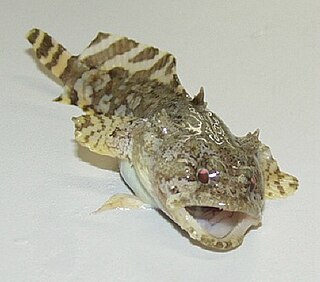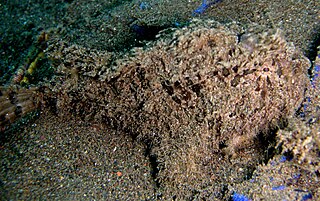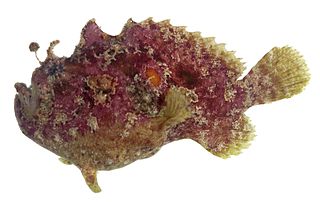
Batrachoididae is the only family in the ray-finned fish order Batrachoidiformes. Members of this family are usually called toadfish, or "frogfish": both the English common name and scientific name refer to their toad-like appearance.

Frogfishes are any member of the anglerfish family Antennariidae, of the order Lophiiformes. Antennariids are known as anglerfish in Australia, where the term "frogfish" refers to members of the unrelated family Batrachoididae. Frogfishes are found in almost all tropical and subtropical oceans and seas around the world, the primary exception being the Mediterranean Sea.

The spotfin frogfish, Antennatus nummifer, is a fish of the family Antennariidae, found in all subtropical oceans to depths of 300 m. It grows to 13 cm (5.1 in) in total length. This species can be found in the aquarium trade.

The striated frogfish or hairy frogfish is a marine fish belonging to the family Antennariidae.

The longlure frogfish is a species of frogfish in the genus Antennarius found in the western Atlantic from Bermuda and the Bahamas, south along the coasts of Central and South America, to Brazil around warm shallow reefs with abundant sponge populations at depths less than 215 feet.

The psychedelic frogfish is a yellow-brown or peach colored frogfish named for its pink and white stripes arranged in a fingerprint pattern. The fish is from waters near Ambon Island and Bali, Indonesia.
Lophichthys boschmai, also known as Arafura frogfish or Boschma's frogfish, is a species of anglerfishes closely related to frogfish. L. boschmai is the only species in the Lophichthydae family. L. boschmai were first reported by Marinus Boseman in 1964 to the Rijksmuseum van Natuurlijke Historie, now known as National Museum of Natural History in Leiden. The species was named after Dutch zoologist, Hildbrand Boschma.

Histiophryne is a genus of frogfishes found in waters ranging from Taiwan to South Australia. There are currently three known species. These fishes are easily distinguished from other anglerfishes as having a reduced luring appendage, a highly evolved form of the first dorsal fin spine. The second and third spines are immobile and reduced as well to mere bumps beneath the skin. The rear fins extend past the body of the fish and meet its tail fin.

The Butler's frogfish or blackspot anglerfish, Tathicarpus butleri, is a rare species of frogfish in the family Antennariidae. The only member of its genus, this species is the most derived member of its family and represents a separate lineage from all other frogfishes, leading to some consideration of it being placed in its own family. It is found off the southern coast of New Guinea, and along the coasts of Western Australia to 33° S latitude, the Northern Territory, and Queensland to 22° S latitude. A benthic species, it inhabits inshore tropical waters and coral reefs to a maximum depth of 145 m (476 ft), though most are found shallower than 45 m (148 ft). Its specific epithet is after its discoverer Dr. Graham Butler.

Antennarius is a genus of 11 species of fish in the family Antennariidae. These fish spend most of their lives on the bottom in relatively shallow water between 20 and 100 m. They can be found worldwide in tropical and subtropical waters. They are well-camouflaged ambush predators that wait for prey fish to pass by. They have "lures" which they move to attract the prey. They have little economic value other than a minor role in the aquarium trade. Commerson's frogfish was the first species in this genus to be described, in 1798.

Halophryne is a genus of toadfishes found in the Pacific and Indian Oceans.

Antennatus is a genus of frogfishes. The last species was described in 2001.

Fowlerichthys is a genus of frogfishes. The first one was described in 1801.

Lophiocharon is a genus of frogfishes native to the Indian Ocean and western Pacific Ocean.

Nudiantennarius subteres, the deep-water frogfish, is a species of frogfish found in the Pacific Ocean around the Philippines and Indonesia. They occur at depths of 64 to 90 metres. This species grows to a length of 7.5 centimetres (3.0 in) SL. This species is the only known member of its genus.

Phyllophryne scortea, the smooth anglerfish, is a species of frogfish endemic to the waters around Australia. This species grows to a length of 10 centimetres (3.9 in) TL. This species is the only known member of its genus.
Alabes is a genus of clingfishes endemic to Australia along the coasts of the Indian and Pacific Oceans. They are small, eel-like fishes with narrow tapering bodies and small heads.

The eastern frogfish is a bottom-dwelling fish endemic to coastal eastern Australia, from Fraser Island, Queensland to Kiama, New South Wales. It is an ambush predator with a large expandable stomach, capable of swallowing crustaceans, molluscs and other fishes whole.

Antennatus coccineus, the scarlet or freckled frogfish, is a species of frogfish originally classified as Chironectes coccineusand most recently Antennarius coccineus in 2012. It lives within tropical waters and has a central distribution being around Indo-East-Pacific areas- excluding Hawaii. The habitat of the scarlet frogfish is in the shallow zones of the ocean. It is found within reef areas, in rocky mounds or sponges where there are places for it to hide amongst from predators. The scarlet frogfish comes in a variety of colours, from tan and brown colours to bright reds and yellows and will grow to a maximum length of 13 centimetres (5.1 in). It can be identified taxonomically through its pectoral rays, the presence of dark patches that appear on its fins and body, along with its lack of distinctive tail base. The scarlet frogfish is not harmful to humans and is not caught by fisheries for consumption purposes, however it has been caught previously for studies relating to the abundance of reef-dwelling fish and as bycatch of shrimp trawling. Similar to other frogfish species, the scarlet frogfish is a predatory carnivore and exhibits a low degree of sociality, only interacting with other scarlet frogfish during their mating period.

Batrachomoeus trispinosus, the three-spined frogfish or Broadbent's frogfish, is a species of Indo-Pacific toadfish, from the largely Old World subfamily, Halophryninae, of the family Batrachoididae. It is the type species of the genus Batrachomoeus.
















